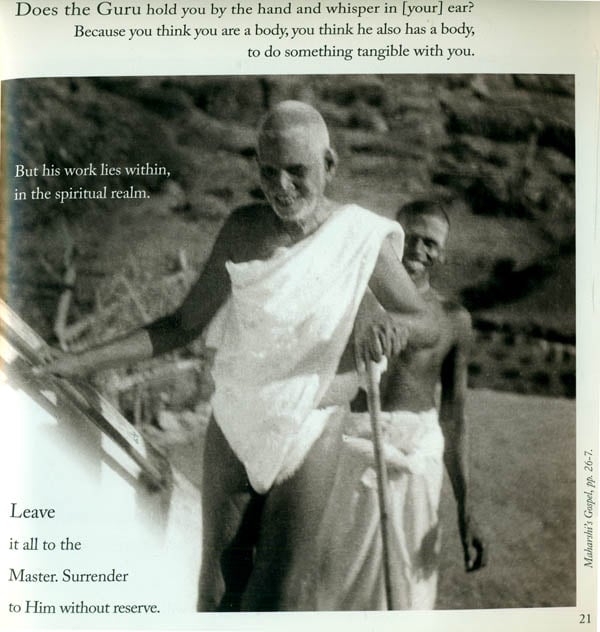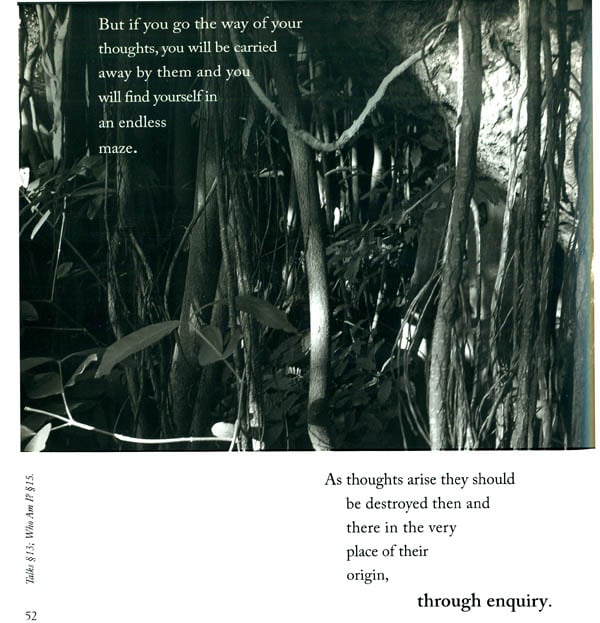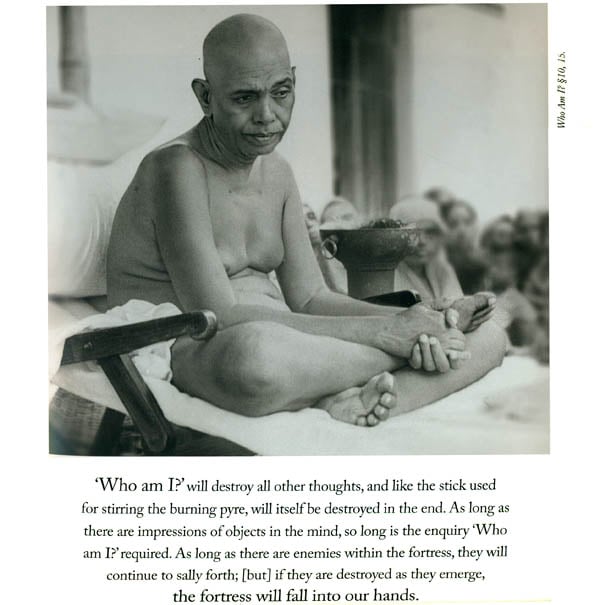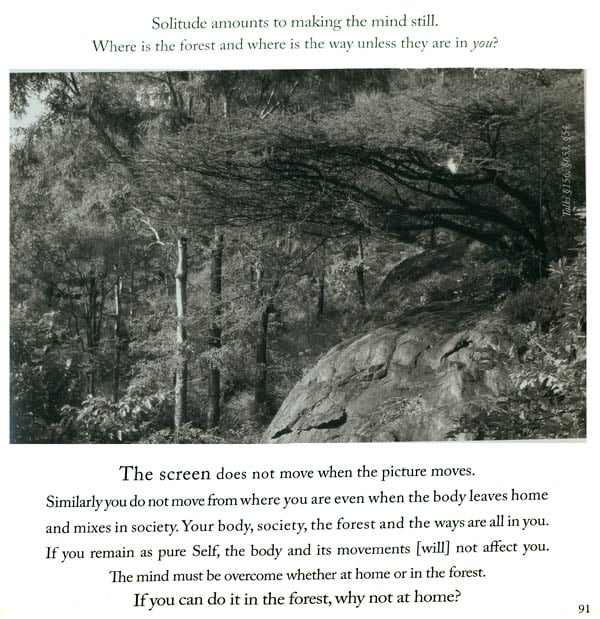
After the Rain (Silent Encounters with Sri Ramana Maharshi)
Book Specification
| Item Code: | NAN629 |
| Publisher: | Sri Ramanasramam, Tamil Nadu |
| Language: | English |
| Edition: | 2012 |
| ISBN: | 9788182881075 |
| Pages: | 108 (Throughout B/W Illustrations) |
| Cover: | Paperback |
| Other Details | 9.0 inch X 9.0 inch |
| Weight | 400 gm |
Book Description
In former days devotees journeyed great distances to be in the Sage's presence and testified time and again to the transformative impact of his darshan. His magnetism. His magnetism was unmistakable and enveloped in deep penetrating gaze which, in an instant, melted away their concerns and changed their lives forever.
Today, not having the benefit of Sri Ramana's physical presence, we turn to his recorded words and images and find ourselves ever grateful to those who collected and preserved the written and photographic elements of Bhagavan's life, affording us the opportunity for his dashan.
The present edition provides us with one such opportunity. A companion volume to the ever-popular Heart is Thy Name, this collection picks up where the earlier book left off, offering fresh glimpses of the Maharshi and the Ashram environs, and garlanding them with penetrating selections from Bhagavan's works.
Who could ever pull themselves away from the captivating power of Bhagavan's form and teaching? Rather let us pull ourselves away from the torrent and chaos of Worldly life and gather in the sunlight of his image and words – and be blessed anew.
Today, not having the benefit of Bhagavan's physical presence, we find ourselves turning to his recorded words and images for our ongoing darshan. Indeed, contemplating a photo or rereading Bhagavan's timeless utterances provides inspiration and guidance for all who would seek him.
The present editiong is a spiritual excursion into the heart of Bhagavan's teaching. A companion volume to the ever-popular Heart is Thy Name, this collection seeks to pay tribute to the aesthetic virtues of its predecessor. Both books, it should be said, owe a debt of gratitude to the earlier Essential Teaching of Ramana Maharshi, published in the United states some nine years ago.
This collection picks up where the previous ones left and offers fresh glimpses of the Maharshi and the Ashram environs, garlanding them with penetrating selections from Talks and other works of Sri Bhagavan. As with the earlier collections, the citations in this volume have been freely adapted without the burden of editorial commentary in order to facilitate a more meditative reading.
In the wake of the storm of samsaric existence, as we gather in the sunlight of Bhagavan's image and word, let us make ourselves receptive once more to seeing and hearing the traces of eternity that so vividly reverberate through his form and teaching – and be blessed anew.
In the encounter with any good piece of art, we find traces of natural perfection, that ineffable something which takes us out of ordinary time and positions us toward the infinite. We often call this something beauty. We find it in the artifacts of the natural world – in the veins of a papal leaf, in the shape of a banyan tree, in the reflections on the surface of a pond, or in the play of light in flowing streams of water. It not difficult to see the parallel between these perfections in nature and those contained in the lines of the guru's face, in the charms of his eyes, where one discerns simultaneously the wellspring of human compassion and that of divine wisdom.
During the course of his life, countless devotees were drawn to Bhagavan Sri Ramana Maharshi, journeyed great distances to be in his presence, and testified time and again to the transformative impact of his darshan. His magnetism was unmistakable and even first-time visitors who had no prior conscious desire to come and see him found themselves unable to leave once in his company. For some it was a few words from his mouth, a not of the head or simply his blissful recumbent form on the sofa in the Old Hall. For other it was a deep penetrating gaze which, in an instant, melted away their oncerns and changed their lives forever.
In the absence of his bodily form, one of the ways we encounter Bhagavan today and seek his sustenance is through his photographic image and the treasure trove of his recorded conversations, translation and poetic works. The aphorism reproduced on the following pages are primarily taken from Talk with Sri Ramana Maharshi, the record that Sri Munagala S. Venkataramiah kept between 1925 and 1939, and Maharshi's Gospel, the collection by Maurice Frydman from about the same time.
Talks and Maharshi's Gospel, one can safely say, are representative of Bhagavan's teaching and offer vivid glimpses of the Sage's manner of interacting with those who came to see him. While Bhagavan instructed mostly through silence, he also taught through spoken words. His teaching style was simple. He never indulged his listener in lengthy discourses, much less pedantry moved directly to the heart of interlocutors' doubts and concerns – even when questioner was not fully conscious what his or her doubt or concern was – and often did so with just few words, a parable from scripture, or an illustration from daily life.
There was a singular theme throughout: All is the Self and all this world and one's own body are contained within It. The solution to any life problem – and indeed the secret to successfully following the spiritual path – is not so much a question of gaining something new but recognising, through a renewed way of seeing, the fundamentl Reality at the root of one's being.
Bhagavan's heuristic genius becomes apparent in this context where, with great facility, he makes the sublime profundities of non-duality available to the layman through simple examples. If down through the ages Advaita Vedanta had been the preserve of pundits and advanced practitioners, Bhagavan makes its insights and conceptual leaps available to the sincere seeker irrespective of any prior grasp of scripture or philosophy.
Devotees have always been fond of likening Bhagavan to Sakshinamurthi, the first of gurus, who taught his disciples, the four sons of Brahma, through a silent gaze. The Ashram literature is replete with accounts attesting to the powerful impact upon the mind and the spirit made by direct eye contact with Sri Bhagavan. Many said that his silence was his true teaching and that he could say more with his glance then any scripture could state in words. Fortunately, some of the potency of this gaze has been captured in photographs as the pages that follow will demonstrate.
Biographical Note
Sri Ramana Maharshi was born Venkataraman in Dcember 1879 on Ardra Darshan Day, the day when, tradition has it, Siva manifested as Nataraja. A blind nurse in attendance 'saw' a wondrous light, and it was pondered what such signs could mean. In spite of this auspicious beginning, however, the child's early life met with calamity. Already at the age of twelve, the boy lost his father. Without a breadwinner, the family could no longer sustain the family home and young Venkataraman was forced to go and live with an uncle in Madurai. At school, though his intelligence and prodigious memory impressed everyone, he showed little promise academically and lacked enthusiasm for study.
But at the age of sixteen, his life took a dramatic turn. In July 1896, while sitting alone in his uncle's house, the boy was seized with a gripping fear of death and the inexorable sensation that, in that very hour, he was going to die:
"Now, death has come. What does it mean? What is it that is dying? This boy dies."
He extended his limbs and held them rigid like a corpse. He held his breath and kept mouth closed:
"This boy is dead. It will be carried to the burning ground and there burnt and reduced to ashes. But with the death of this body, am 'I' dead? Is the body 'I'? The material body dies, but the spirit transcending it cannot be touched by death. I am therefore deathless spirit."
In spite of these strong sensations, Venkataraman did not meet with physical death that day. But he did find that he had undergone a substantial change. First of all, having conquered death, he no longer had any anxiety about the prospect of dying. But more significantly, from this time onward, he found himself in a continuous state of meditative absorption, indifferent to the events of ordinary life or the demands placed on him by the outside world. Within weeks, he made up his mind to leave home, never to return.
At the end of August 1896, he set off in secret for Arunachala. On arrival, he had his head shaved, discarded his thread, clothes and other possessions, donned a loincloth and placed himself at the mercy of the Holy Hill. He later took up residence on the Mountain, principally at Virupaksha Cave (1900-16) and Skandasramam (1916-22). In meantime, his whereabouts were made known to the family and they came to visit him, though failing in their efforts to persuade him to return home. Eventually his mother and younger brother came to join him at Skandasramam.
In 1922, when his mother attained final liberation in his arms, devotees carried her remains down to the foot of the Hill for burial. Daily rites were performed at her tomb and a few devotees sifted down to be on hand for that purpose. Within six months, Bhagavan Ramana also moved down, resulting in the founding of a large ashram on the grounds surrounding her shrine. As the flood of devotees increased, building were erected and the community took name Sri Ramanasramam.
For thirty years thereafter, Bhagavan Ramana received all who sought his darshan. From local householders to foreign dignitaries, as well as pundits, professors, writers and poets, Sri Ramana was tireless in making himself available to all who came to him. As devotees began to write and publish accounts of their experiences, and as translations were made if Bhagavan's teachings and poetic compositions, the Sage's prominence grew and his fame spread throughout South India and the world.
In April 1950, at the moment a shooting star descended beyond Arunachala's summit, Sri Ramana Maharshi left the body in the company of thousands of adoring devotees. In the decades that followed, the community that had grown up him continued to thrive, endures u9ntil hte present day.











